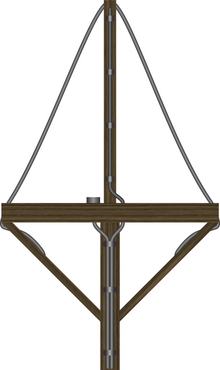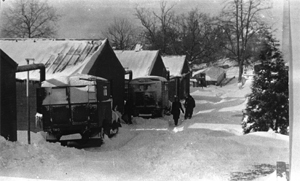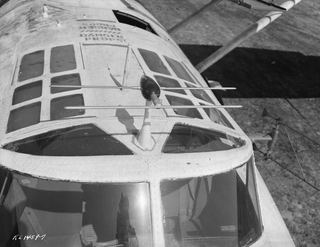
The R600A Metox, named after its manufacturer, was a pioneering high-frequency radar warning receiver (RWR) used by the German forces on U-boats from 1942-45. It was initially installed to receive signals used by British radars.

The R600A Metox, named after its manufacturer, was a pioneering high-frequency radar warning receiver (RWR) used by the German forces on U-boats from 1942-45. It was initially installed to receive signals used by British radars.
The Metox was manufactured by a small French company in occupied Paris. It was tuned to receive the 1.5-metre (200 MHz) signals used by many British radars of the early and mid-World War II era, notably the ASV Mk. II radar used by RAF Coastal Command to attack U-boats. It is not clear whether the design was German or French or both. It was installed on German U-boats starting in 1942 and used until the end of the war. [1] The system given the official title of FuMB 1 (for Funkmessbeobachtungsgerät, Radio measuring device).
From July 1940, the British fitted the RAF Mk II AI (Airborne Interception) radar into Coastal Command aircraft for use as the Mk II "1+1⁄2-metre ASV". [2] The radar's known AI weaknesses — problems due to land clutter and inability to determine height, which caused its failure in night fighters — were no handicap in this new role. With two range scales, 0–9 mi (0–14 km) and 0–36 mi (0–58 km), it could detect surfaced U-boats at up to 12 mi (19 km) and land at up to 70 mi (110 km) away, though a typical U-boat detection range was 5 mi (8 km). The radar had a fairly crude display but was able to give the range and an approximate direction within an arc either side of the aircraft heading. Returns were lost in sea clutter once the aircraft was within about 1 mi (1.6 km) of the U-boat but usually by then, the aircraft was within visual range—and the U-boat was well into a crash dive.
Wing Commander Humphry de Verde Leigh developed the Leigh light, a powerful floodlight steered by the ASV radar, allowing aircraft to search for U-boats at night. The U-boat was tracked by the radar with the light switched off, following the radar track. Once the returns were lost, the light would be switched on bathing the U-boat in light. The first successful attack was on the U-502 on 5 July 1942. The sudden light was often the first indication to the U-boat crew that they had been found. The Leigh light was initially very successful, particularly in the Bay of Biscay. Metox was the German answer to the British radar. Metox sets received the transmitted pulses from the ASV and rendered them as audible beeps. It enjoyed the usual advantage of radar detectors over radar in that the signal is direct and only had to travel one way whereas the radar has to detect the very weak reflection from the submarine. [3] Most radars increase the number of pulses and decrease the width of the pulses when switched to a shorter range, the shorter pulse widths allow the radar to look at closer objects. Metox exploited the fact that once the radar operator changed the range indication from 36 miles (58 km) to 9 miles (14 km), the pulse repetition frequency of the radar's transmitter doubled. Radar cannot detect any reflections returned earlier than half a pulse width so when the U-boat was closer than 9 miles (14 km) the operator would change to the shorter scale. If the Metox set started beeping at twice the rate, the U-boat knew that they had been detected. By the time the aircraft was close enough to the U-boat's position to illuminate with the Leigh light, the U-boat was well under the water. As a bonus, the Metox set would also provide warning in excess of visual range in daylight.
In December 1942 British codebreakers regained the ability to decipher messages encrypted with naval Enigma machines and the Germans noticed the resulting increase in U-boat sightings. Based on their confidence in the Enigma machine, as well as the testimony of a captured British bomber pilot, the Germans came to the erroneous conclusion that the Allies could detect emissions produced by the Metox itself. [4] The executive officer of U-230 , Captain Herbert Werner said of Metox, "Then, on August 3 [1943], we received a message from Headquarters which had a greater impact on our lives than any since the beginning of the Allied offensive. [5]
ALL U-BOATS. ATTENTION. ALL U-BOATS. SHUT OFF METOX AT ONCE. ENEMY IS CAPABLE OF INTERCEPTING. KEEP RADIO SILENCE UNTIL FURTHER NOTICE. [5]
Metox was eventually countered by a version of the 10 cm (3 GHz) H2S radar, which Metox could not detect and once again the Leigh light forced U-boat crews to refuse to run surfaced at night.[ citation needed ] Even during the day the new radar was easily able to detect a submerged U-boat's periscope or snorkel, which earlier radars employing longer wavelengths could not do. Metox was superseded by the Naxos receiver that detected 10-centimetre wavelength H2S signals but was unable to detect the higher, 3 cm (10 GHz) frequency of the American H2X radar.[ citation needed ]

Radar is a system that uses radio waves to determine the distance (ranging), direction, and radial velocity of objects relative to the site. It is a radiodetermination method used to detect and track aircraft, ships, spacecraft, guided missiles, motor vehicles, map weather formations, and terrain.

The Leigh Light (L/L) was a British World War II era anti-submarine device used in the Battle of the Atlantic. It was a powerful carbon arc searchlight of 24 inches (610 mm) diameter fitted to a number of the British Royal Air Force's Coastal Command patrol bombers to help them spot surfaced German U-boats at night.

H2S was the first airborne, ground scanning radar system. It was developed for the Royal Air Force's Bomber Command during World War II to identify targets on the ground for night and all-weather bombing. This allowed attacks outside the range of the various radio navigation aids like Gee or Oboe, which were limited to about 350 kilometres (220 mi) of range from various base stations. It was also widely used as a general navigation system, allowing landmarks to be identified at long range.

The Naxos radar warning receiver was a World War II German countermeasure to S band microwave radar produced by a cavity magnetron. Introduced in September 1943, it replaced Metox, which was incapable of detecting centimetric radar. Two versions were widely used, the FuG 350 Naxos Z that allowed night fighters to home in on H2S radars carried by RAF Bomber Command aircraft, and the FuMB 7 Naxos U for U-boats, offering early warning of the approach of RAF Coastal Command patrol aircraft equipped with ASV Mark III radar. A later model, Naxos ZR, provided warning of the approach of RAF night fighters equipped with AI Mk. VIII radar.

Oboe was a British bomb aiming system developed to allow their aircraft to bomb targets accurately in any type of weather, day or night. Oboe coupled radar tracking with radio transponder technology. The guidance system used two well-separated radar stations to track the aircraft. Two circles were created before the mission, one around each station, such that they intersected at the bomb drop point. The operators used the radars, aided by transponders on the aircraft, to guide the bomber along one of the two circles and drop the bombs when they reached the intersection.

The history of radar started with experiments by Heinrich Hertz in the late 19th century that showed that radio waves were reflected by metallic objects. This possibility was suggested in James Clerk Maxwell's seminal work on electromagnetism. However, it was not until the early 20th century that systems able to use these principles were becoming widely available, and it was German inventor Christian Hülsmeyer who first used them to build a simple ship detection device intended to help avoid collisions in fog. True radar which provided directional and ranging information, such as the British Chain Home early warning system, was developed over the next two decades.

A pulse-Doppler radar is a radar system that determines the range to a target using pulse-timing techniques, and uses the Doppler effect of the returned signal to determine the target object's velocity. It combines the features of pulse radars and continuous-wave radars, which were formerly separate due to the complexity of the electronics.

The Telecommunications Research Establishment (TRE) was the main United Kingdom research and development organisation for radio navigation, radar, infra-red detection for heat seeking missiles, and related work for the Royal Air Force (RAF) during World War II and the years that followed. It was regarded as "the most brilliant and successful of the English wartime research establishments" under "Rowe, who saw more of the English scientific choices between 1935 and 1945 than any single man."

An airport surveillance radar (ASR) is a radar system used at airports to detect and display the presence and position of aircraft in the terminal area, the airspace around airports. It is the main air traffic control system for the airspace around airports. At large airports it typically controls traffic within a radius of 60 miles (96 km) of the airport below an elevation of 25,000 feet. The sophisticated systems at large airports consist of two different radar systems, the primary and secondary surveillance radar. The primary radar typically consists of a large rotating parabolic antenna dish that sweeps a vertical fan-shaped beam of microwaves around the airspace surrounding the airport. It detects the position and range of aircraft by microwaves reflected back to the antenna from the aircraft's surface. The secondary surveillance radar consists of a second rotating antenna, often mounted on the primary antenna, which interrogates the transponders of aircraft, which transmits a radio signal back containing the aircraft's identification, barometric altitude, and an emergency status code, which is displayed on the radar screen next to the return from the primary radar.
A radar system uses a radio-frequency electromagnetic signal reflected from a target to determine information about that target. In any radar system, the signal transmitted and received will exhibit many of the characteristics described below.

The Mid-Atlantic gap is a geographical term applied to an undefended area of the Atlantic Ocean during the Battle of the Atlantic in the Second World War. The region was beyond the reach of land-based RAF Coastal Command antisubmarine (A/S) aircraft. This resulted in heavy merchant shipping losses to U-boats. It is frequently known as The Black Pit, as well as the Atlantic Gap, Air Gap, Greenland Gap, or just "the Gap". The gap was eventually closed in May 1943, as growing numbers of VLR Liberators and escort carriers became available, and as basing problems were addressed.
Radar in World War II greatly influenced many important aspects of the conflict. This revolutionary new technology of radio-based detection and tracking was used by both the Allies and Axis powers in World War II, which had evolved independently in a number of nations during the mid 1930s. At the outbreak of war in September 1939, both the United Kingdom and Germany had functioning radar systems. In the UK, it was called RDF, Range and Direction Finding, while in Germany the name Funkmeß (radio-measuring) was used, with apparatuses called Funkmessgerät . By the time of the Battle of Britain in mid-1940, the Royal Air Force (RAF) had fully integrated RDF as part of the national air defence.

Radar, Aircraft Interception, Mark IV, also produced in the USA as SCR-540, was the world's first operational air-to-air radar system. Early Mk. III units appeared in July 1940 on converted Bristol Blenheim light bombers, while the definitive Mk. IV reached widespread availability on the Bristol Beaufighter heavy fighter by early 1941. On the Beaufighter, the Mk. IV arguably played a role in ending the Blitz, the Luftwaffe's night bombing campaign of late 1940 and early 1941.

Radar, Aircraft Interception, Mark VIII, or AI Mk. VIII for short, was the first operational microwave-frequency air-to-air radar. It was used by Royal Air Force night fighters from late 1941 until the end of World War II. The basic concept, using a moving parabolic antenna to search for targets and track them accurately, remained in use by most airborne radars well into the 1980s.
German Luftwaffe and Kriegsmarine Radar Equipment during World War II, relied on an increasingly diverse array of communications, IFF and RDF equipment for its function. Most of this equipment received the generic prefix FuG, meaning "radio equipment". During the war, Germany renumbered their radars. From using the year of introduction as their number, they moved to a different numbering scheme.

Radar, Air to Surface Vessel, Mark II, or ASV Mk. II for short, was an airborne sea-surface search radar developed by the UK's Air Ministry immediately prior to the start of World War II. It was the first aircraft-mounted radar of any sort to be used operationally. It was widely used by aircraft of the RAF Coastal Command, Fleet Air Arm and similar groups in the United States and Canada. A version was also developed for small ships, the Royal Navy's Type 286.
Radar, Air to Surface Vessel, or ASV radar for short, is a classification used by the Royal Air Force (RAF) to refer to a series of aircraft-mounted radar systems used to scan the surface of the ocean to locate ships and surfaced submarines. The first examples were developed just before the opening of World War II and they have remained a major instrument on patrol aircraft since that time. It is part of the wider surface-search radar classification, which includes similar radars in ground and ship mountings.

Radar, Air-to-Surface Vessel, Mark III, or ASV Mk. III for short, was a surface search radar system used by RAF Coastal Command during World War II. It was a slightly modified version of the H2S radar used by RAF Bomber Command, with minor changes to the antenna to make it more useful for the anti-submarine role. It was Coastal Command's primary radar from the spring of 1943 until the end of the war. Several improved versions were introduced, notably the ASV Mark VI, which replaced most Mk. IIIs from 1944 and ASV Mark VII radar, which saw only limited use until the post-war era.

SW1C, short for Surface Warning, Model 1, Canadian, was an early radar system developed by the National Research Council of Canada (NRC) for the Royal Canadian Navy (RCN).